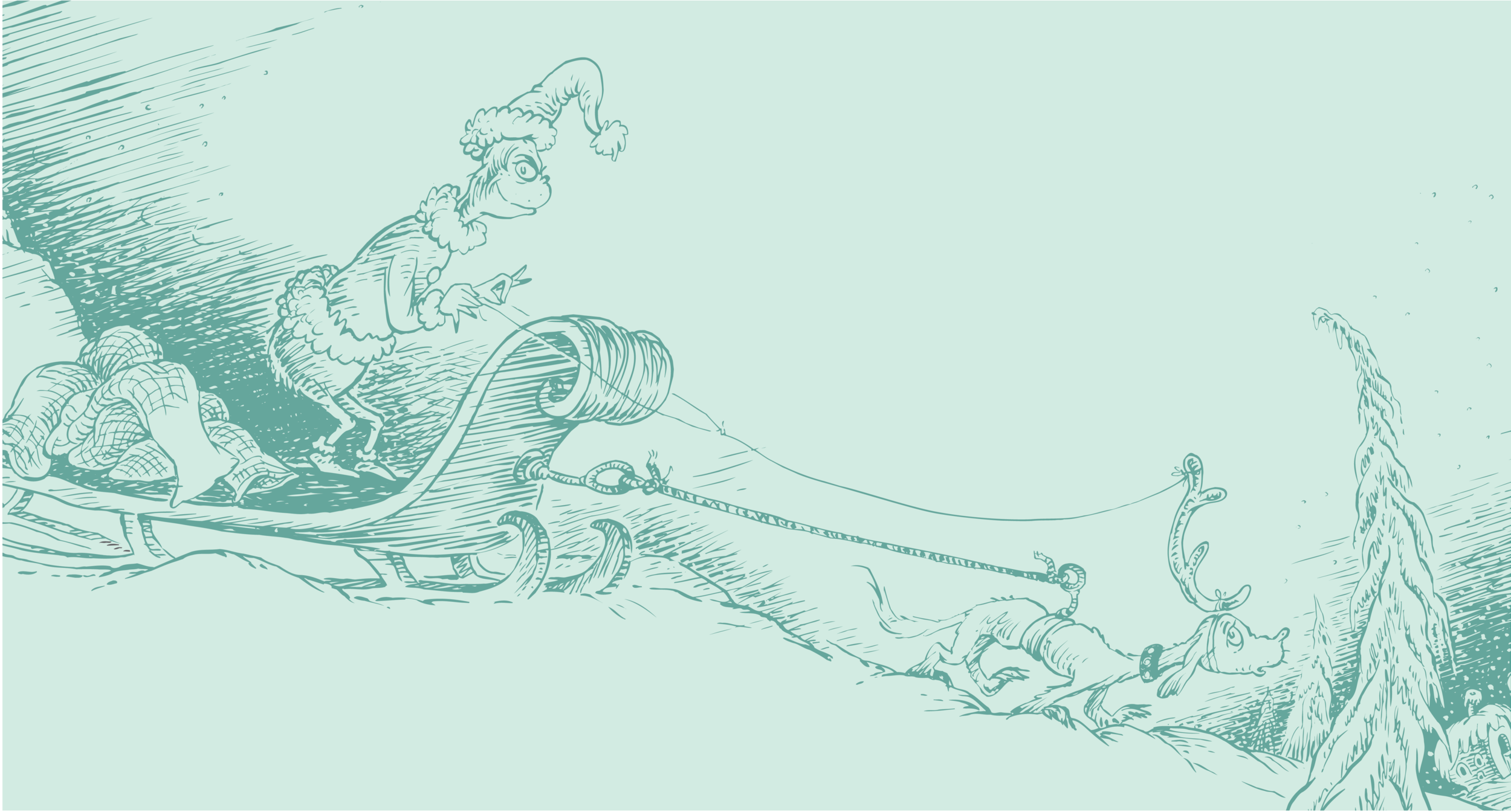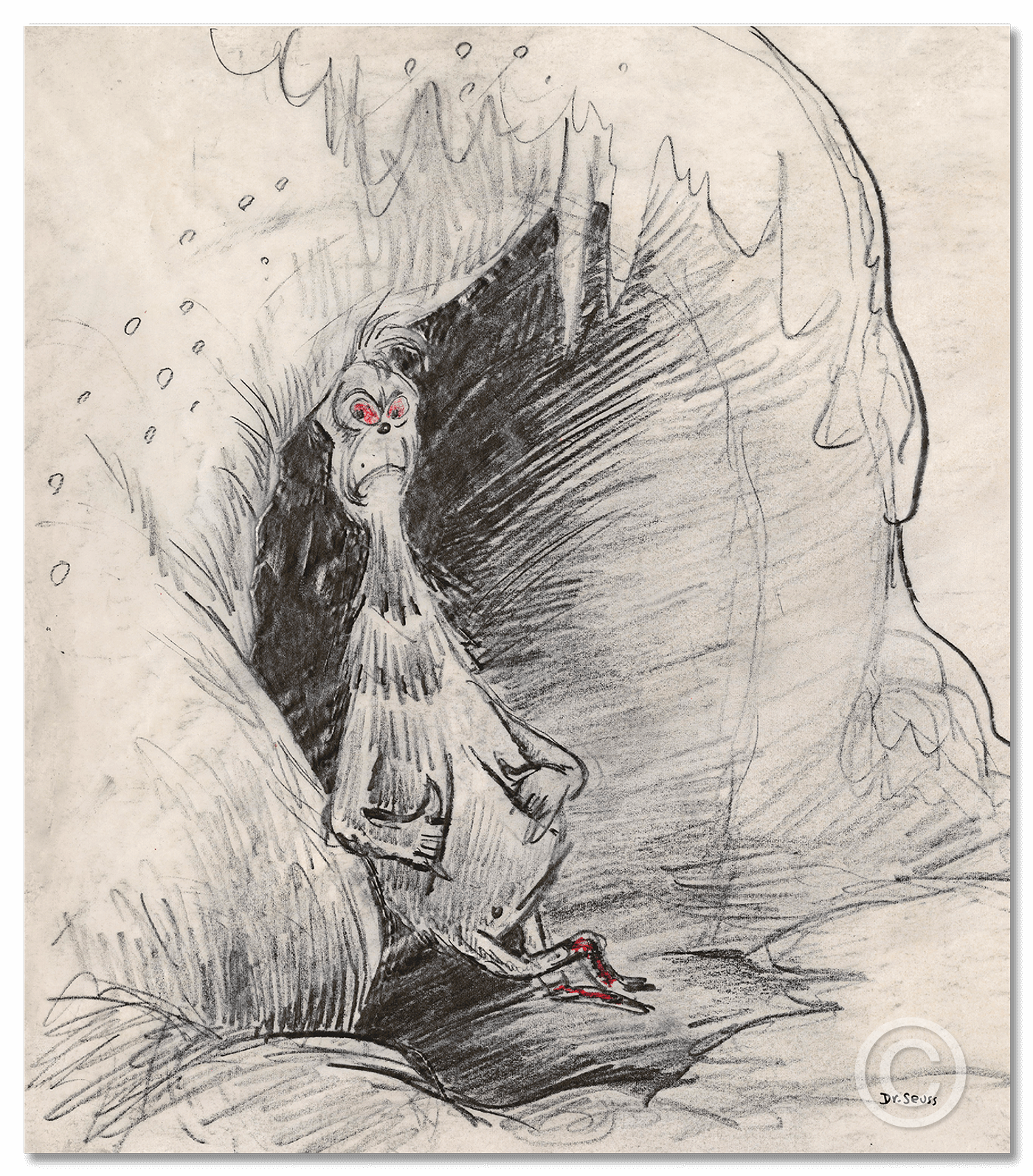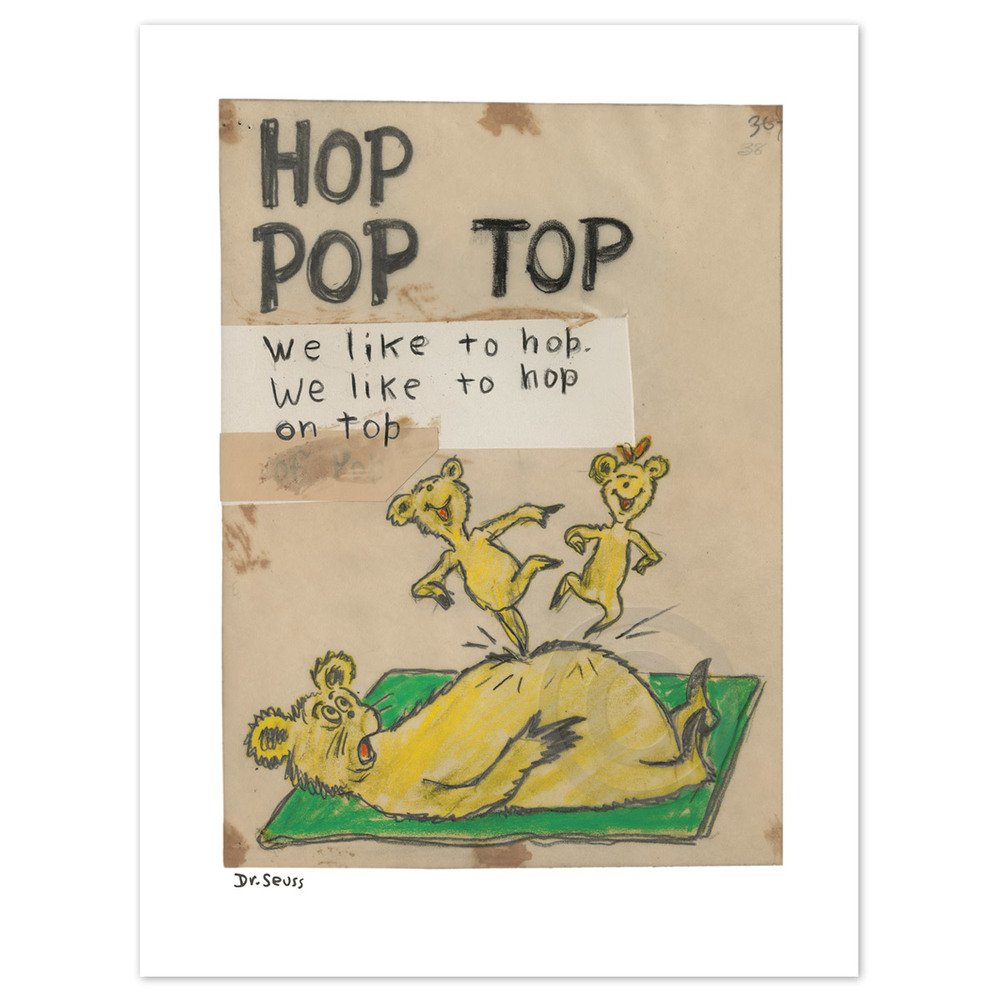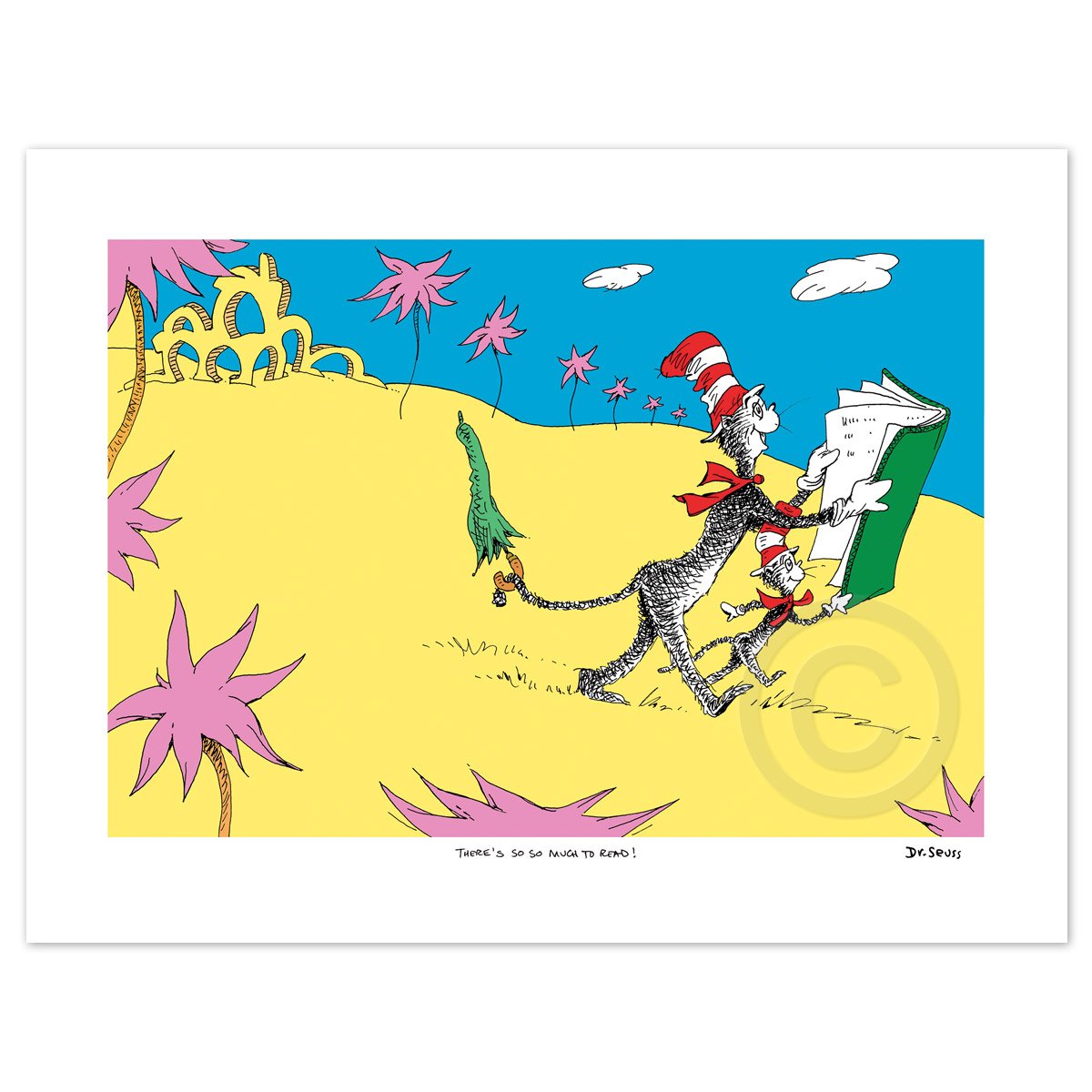“These artworks and the accompanying story aren’t about a dislike for Christmas. It is the opposite. The Grinch is about rediscovering the magic of the holidays and our gratitude for friends and family.”
How The Grinch Stole Christmas! - Cover
Lithograph on Somerset Paper
Image and Paper Size: 17.5” x 14”
Limited Edition of 2500 Arabic Numbers, 99 Patrons’ Collection, 155 Collaborators’ Proofs
395 USD - Unframed
Dr. Seuss came up with the idea for The Grinch the day after Christmas when he looked in the mirror and saw a rather Grinch-ish look on his face. “Something had gone awfully wrong with Christmas or maybe with me,” he said. Weary of the over-commercialization of Christmas and sensing that the meaning of the holiday was being lost in the wrappings and ribbons, boxes and bows, Ted Geisel sat down and wrote How The Grinch Stole Christmas! when he was 53 years old.
““The Grinch’s small heart grew three sizes that day!””
The moment of redemption in Dr. Seuss’s book is when, after having stolen all the toys from his neighboring Whos down in Who-ville, they still wake up singing on Christmas morning.
As Seuss writes: “And after he puzzled over it until his “puzzler was sore, ‘Maybe Christmas,’ he thought, ‘doesn’t come from a store. Maybe Christmas . . . perhaps . . . means a little bit more!’” When writing The Grinch, Dr. Seuss was expressing his own 53-year-old concerns about the holiday. It took Seuss time to figure out how he felt about Christmas, but as he would later say of The Grinch, “It’s not how you start out that counts. It’s what you are at the finish.”
Love and Music
Mixed-Media Pigment Print on Archival Canvas
Image Size: 36” x 28.25” with additional canvas border
Limited Edition of 850 Arabic Numbers, 99 Patrons’ Collection, 155 Collaborators’ Proofs, 5 Hors d’Commerce,
2 Printer's Proofs
2,195 USD - Unframed
In 1957, Random House named Ada Vine as Production Manager of the newly formed Beginner Books division, which Ted oversaw. The Cat in the Hat was their first project together, followed in 1960 by the blockbuster Green Eggs and Ham. Ada would work alongside Dr. Seuss for the next 20 years.
On the occasion of her retirement in 1977, Ted painted Love and Music as a seemingly self-satirizing homage to their many years spent together. Here we see Ted in a confluence of iconic characters from those two early projects with Ada, The Cat in the Hat and Sam-I-am’s famous antagonist from Green Eggs and Ham. Love and Music was presented to Ada Vine at her retirement party.
Do You Like Green Eggs and Ham? - Diptych
Fine Art Pigment Print on Acid-Free Paper
Image and Paper Size: 14.25” x 32.5”
Limited Edition of 850 Arabic Numbers, 99 Patrons’ Collection, 155 Collaborators’ Proofs, 5 Hors d’ Commerce
2 Printer’s Proofs
995 USD - Unframed
“Green Eggs and Ham pairs just 50 words with Dr. Seuss’s powerful, yet simple, six-color drawings to make an indelible impression on four generations of readers.”
Ted Geisel had a unique ability to cut to the heart of the matter. He would spend as much as a year on a new book, tacking up written pages and pencil drawings across the corkboard walls of his studio. Slowly, over the course of many months, he would sift through his work in search of the simplest, most powerful ideas to propel his story forward.
Ted’s dedication to such simplicity can be seen here in his concept drawing for this work. The lower right-hand corner reveals his “word count” to be certain he doesn’t exceed the 50-word challenge.
A Large Family of Dilemmas
Serigraph on Archival Canvas
Image Size: 25” x 35.5” with additional canvas border
Limited Edition of 850 Arabic Numbers, 99 Patrons’ Collection, 155 Collaborators’ Proofs, 5 Hors d’Commerce
2 Printer's Proofs
1,895 USD - Unframed
Life is a great balancing act between what we should do and what we want to do…. Between how far we get stuck in a jam and how long we take to find our way out…. Between turning left or right, forward or back.
We all face large and small dilemmas nearly every day. Life’s beauty is in the collective outcomes of such precarious situations, with each experience bringing us closer to knowing who we are and what we hope to become. As such, encountering “a large family of dilemmas” throughout our years seems the best path to a life well lived.
The Birds and the Trees
Mixed Media Pigment Print on Archival Canvas
Image Size: 22” x 44” with additional canvas border
Limited Edition of 850 Arabic Numbers, 99 Patrons’ Collection, 155 Collaborators’ Proofs, 5 Hors d’Commerce, 2 Printer’s Proofs
1,895 USD - Unframed
For centuries we have pursued the ability to soar like a bird, wings spread and carried by the wind. Flight represents the unbridled grace of movement and the unrestricted thrill of freedom. To fly unimpeded is a fantasy of surreal proportions and a constant source of inspiration throughout time.
Dr. Seuss witnessed the magic of flight firsthand, not only on his travels around the world, but also directly from his studio window. It was there that he watched birds migrate up and down the California coast. He watched the native birds nest within the tropical flora and fauna that populated the hillside on which he lived. The view from his studio inspired his creativity and made its way into countless paintings and book projects throughout his career.
I ALWAYS Pick Up All My Play-Things
Fine Art Pigment Print with Collage on Acid-Free Paper
Image and Paper Size: 14” x 19”
Limited Edition of 1500 Arabic Numbers, 99 Patrons' Collection, 155 Collaborators' Proofs,
5 Hors d'Commerce
695 USD - Unframed
“Rather than create children’s books based upon FOLLOWING the rules, Dr. Seuss flipped that premise with The Cat and created books that encouraged us all to QUESTION the rules.”
The Cat in the Hat presents perhaps one of the best examples of the conundrums Dr. Seuss leaves in the hands of six-year-olds to solve. At the end of the book, after the Cat in the Hat wrecks the home and returns to clean everything up, the mother finally appears and asks, “Did you have any fun? Tell me. What did you do?” Instead of answering the question, Dr. Seuss passes the conundrum from the characters in the book to the readers who are now challenged to answer the dilemma.
The Cat’s Debut - Diptych
Serigraph on Coventry Paper
Image and Paper Size: 25.75” x 35.5”
Limited Edition of 850 Arabic Numbers, 99 Patrons’ Collection prints, 155 Collaborators’ Proofs, 5 Hors d'Commerce, 2 Printer's Proofs
1,695 USD - Unframed
A book’s endpapers quite literally hold the volume together, binding the interior pages to the cover. They also provide an exciting opportunity to set the book’s tone, to debut what’s ahead for the reader and, ultimately, to “bind” the story that rests between them. The Cat’s Debut features Dr. Seuss’s (aka Ted Geisel’s) early concept drawing for The Cat in the Hat endpapers.
The endpapers were The Cat’s coming out party. Ted spent countless hours working and reworking his Cat’s image. Over the course of a year, he created a magical personality instilled with wonder, anticipation, and mischief!
And then who should come up but the CAT IN THE HAT!
Pigment Print and Collage on acid-free paper
Image Size: 13.75” x 20.5”
Limited Edition of 1500 Arabic Numbers, 99 Patrons’ Collection prints, 155 Collaborators’ Proofs,
5 Hors d’Commerce, 2 Printer's Proofs
795 USD - Unframed
Ted Geisel (aka Dr. Seuss) drew each page for every Dr. Seuss book he wrote. What many people don’t realize is that for each final-line drawing, he would create multiple concept drawings leading up to the final published image. The images would be tirelessly refined, along with the text for each page, with subtle adjustments made to characters and nuanced shifts to the writing.
In the work done for The Cat in the Hat Comes Back, Ted did something rarely found in his early-stage concept drawings. Here he combines pen and ink with colored pencil, crayon, and a watercolor wash to create the background. The resulting image takes on a unique, painterly quality rarely found in the development phase of his other children’s books.
Hop Pop Top - Single
Fine Art Pigment Print on Acid-Free Paper
Image and Paper Size: 18.5” x 14”
Limited Edition of 2500 Arabic Numbers, 155 Collaborators’ Proofs
395 USD - Unframed
In 1963, Dr. Seuss wrote Hop On Pop, a tribute to fatherhood. Dr. Seuss's own father, T.R. Geisel was very supportive of his son and a great influence on his artwork.
There's so, so much to read!
Fine Art Pigment Print on Acid-Free Paper
Image and Paper Size: 14.5” x 19”
Limited Edition of 2500 Arabic Numbers, 99 Patrons’ Collection, 155 Collaborators’ Proofs, 5 Hors d'Commerce
2 Printer's Proofs
395 USD - Unframed
There's so so much to read! has been meticulously re-created from Dr. Seuss's 1978 beginner book, I Can Read with My Eyes Shut! By reintroducing his lovable and mischievous Cat in the Hat, now accompanied by an impressionable young Cat protégé, Theodor Seuss Geisel continued his lifelong legacy of promoting literacy with this book's thematic message that reading can be fun, funny, and education, all at the same time.
Kid, You’ll Move Mountains! Concept Drawing
Fine Art Pigment Print on Acid-Free Paper
Dimensions: 25.25” x 36”
Limited Edition of 850 Arabic Numbers, 99 Patrons’ Collection, 155 Collaborators’ Proofs, 5 Hors d’Commerce, and 2 Printer’s Proofs
2,195 USD - Unframed
This may be one of the most deeply personal, and profoundly impactful of all the messages he conveyed in his lifetime. In order for it to not only summarize his own life, but to summarize ours and all who may read it in the future, Ted seemed to know that authenticity was paramount.
He tells us quite simply that nothing is 100% certain, life doesn’t work that way. There is always an element of the unknown. However, once we embrace that notion, anything is possible.
In the final image of his entire publishing career, he encourages us to believe in ourselves, trust the journey, embrace the unknown, and ultimately, get the most out of the life we are leading.
““Will you succeed? Yes! You will indeed!
(98 and ¾ guaranteed)…
Kid, you’ll move mountains!” ”
